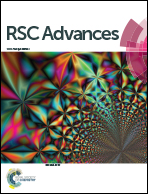Extensive removal of thallium by graphene oxide functionalized with aza-crown ether†
Abstract
Thallium (Tl) is a highly toxic heavy metal, and its pollution and remediation in aquatic environments has attracted considerable attention. To reduce or remove Tl pollution in the environment, various strategies have been applied. Graphene oxide (GO) has abundant oxygen-containing functional groups, indicating its high application potential for pollution remediation via methods involving binding to metal ions or positively charged organic molecules or electrostatic interaction and coordination. However, the adsorption of Tl to GO occurs via physical adsorption, for which the adsorption efficiency is low. Therefore, herein, we report a new method to effectively remove Tl pollution in water. We combined GO with aza-crown ether, which enhanced the electronegativity and ability to bind metal ions. The functionalized graphene oxide (FGO) demonstrated high efficiency through a wide pH gradient of 5–10, with a dominant Tl(I) adsorption capacity (112.21 mg g−1) based on the Langmuir model (pH 9.0, adsorbent concentration of 0.8 g L−1). The adsorption of Tl(I) during removal fit a pseudo-second-order kinetic model well. The mechanisms of Tl removal involve physical and chemical adsorption. In summary, our study provides a new method for the detection and treatment of Tl-containing wastewater by using FGO.



 Please wait while we load your content...
Please wait while we load your content...